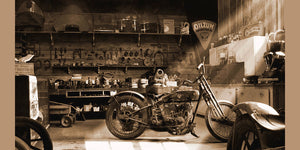Find Competitive Rates on Motocross Parts NZ for Every Bike
Wiki Article
Recognizing the Necessary Parts of a Motorcycle: A Comprehensive Guide for Fanatics
For bike lovers wanting to raise their riding experience and ensure their bikes run smoothly, understanding the essential components of a motorcycle is extremely important. Each aspect, from the engine's complex workings to the essential function of the stopping devices, not only influences performance yet likewise security and convenience. This guide will certainly go through the basic parts that every rider need to recognize with, enabling educated options in both maintenance and potential upgrades. As we begin this exploration, one must ask: how does each element engage to develop the smooth ride every fanatic seeks?Engine Parts

The camshaft plays an important duty in managing the timing of the engine's valves, ensuring the specific opening and closing needed for efficient gas and air intake, as well as exhaust expulsion. This timing is essential to keeping optimum engine performance and effectiveness. Furthermore, the carburetor or gas shot system, depending upon the bike model, is in charge of mixing air with gas in the right ratio for combustion.
The cooling system, either air or liquid-based, works to keep the engine's temperature level within operational restrictions, avoiding overheating and ensuring long life - motocross gear nz. Each component, carefully designed and incorporated, adds to the seamless operation of the engine, specifying the motorbike's power outcome and total performance
Transmission System
Essential to the bike's functionality, the transmission system guarantees efficient power transfer from the engine to the wheels. This system consists of several critical components, including the clutch, transmission, and final drive, each playing an essential duty in converting the engine's power right into motion. The clutch, usually run by a hand bar, offers to involve and disengage the engine from the transmission, permitting for smooth gear adjustments and regulated acceleration.The gearbox, typically referred to as the transmission appropriate, consists of a set of equipments that riders can manually change with to adjust the bike's speed and torque outcome. These equipments are arranged in a sequence that makes it possible for the motorcycle to speed up smoothly and preserve optimal engine performance throughout numerous speeds. A lot of motorcycles use a sequential gearbox, calling for the biker to change gears in an established order.
Braking Systems
While understanding the transmission system is vital to harnessing a bike's power, similarly important is the capacity to manage and quit that power effectively, which is where stopping devices come into play. Brakes are crucial for safety and security and performance, supplying the biker with the needed control to navigate different surfaces and problems. Usually, motorcycles feature two sorts of braking systems: disc brakes and drum brakes.Disc brakes are a lot more common in modern motorcycles because of their exceptional efficiency. They contain a brake disc, caliper, and pads. When triggered, the caliper presses the brake pads against the spinning disc, transforming kinetic energy right into warmth, consequently reducing electric dirt bike for sale near me the wheel. This system provides better heat dissipation, constant performance, and enhanced stopping power, specifically in wet problems.
Alternatively, drum brakes, though much less typical, are still found in some bikes. They work by pressing brake footwear against the internal surface area of a drum affixed to the wheel. While normally much less effective in warm dissipation and stopping power, drum brakes are simpler and a lot more affordable.
Recognizing these braking systems' subtleties allows bikers to preserve their bikes appropriately and value the design that makes certain efficient and risk-free quiting.
Suspension and Steering
Suspension and guiding systems are crucial components that dramatically influence a bike's handling and ride convenience. The shock absorber, including forks at the front and shock absorbers at the back, takes in road abnormalities, improving stability and control. Front forks, upside down or commonly telescopic, compress and rebound to alleviate impacts, while rear shock absorbers keep tire contact with the road, important for grip and security.Steering, focused around the handlebars, connects the cyclist to the bike's directional control. The steering head bearings guarantee smooth operation, allowing exact maneuverability. Appropriate positioning and maintenance of these bearings are important for foreseeable guiding feedback and lowering rider exhaustion.
The suspension's adjustability is an additional critical element; preload, damping, and rebound setups allow modification to suit various riding designs and conditions. This versatility is essential for optimizing performance, whether browsing urban streets or dealing with sturdy tracks. Advancements like electronic suspension systems use real-time modifications, enhancing adventure high quality throughout diverse terrains.

Electric Systems
After making certain a smooth and controlled adventure via effective suspension and steering systems, attention transforms to the electrical systems, an essential aspect of modern motorcycles. These systems play a vital function not just bike racing helmet in starting the engine however additionally in powering different parts that improve the performance and safety of the motorbike.At the heart of a motorbike's electric system is the battery, which shops electrical power necessary for beginning the engine and powering auxiliary systems - motorbike shop. The generator or generator, paired with the rectifier-regulator, makes certain the battery stays billed while the motorbike functions, transforming power right into electrical energy and preserving voltage degrees
The ignition system, an additional crucial component, is accountable for stiring up the air-fuel blend in the engine's cylinders. Modern bikes typically utilize an electronic ignition system, providing higher performance and dependability contrasted to standard systems.
Lights systems, consisting of fronts lights, tail lights, and indications, are also important, ensuring exposure and safety and security for the cyclist. Additional digital parts such as sensing units, control units, and presents add to sophisticated functions like fuel injection management, anti-lock braking systems (ABDOMINAL MUSCLE), and digital control panels, further boosting the riding experience.
Final Thought
An extensive comprehension of a motorcycle's essential components, including the engine, transmission system, stopping systems, suspension, steering, and electrical systems, is crucial for fanatics aiming to maximize efficiency, safety, and comfort. Proficiency of these elements enables notified choices pertaining to upkeep and upgrades, ultimately enhancing the riding experience. By integrating this expertise, cyclists can guarantee their bikes operate at peak efficiency and integrity, thereby taking full advantage of both enjoyment and long life of their lorries.For motorcycle lovers looking to boost their riding experience and guarantee their bikes run smoothly, recognizing the essential elements of a motorcycle is paramount.Essential to the motorbike's functionality, the transmission system makes certain efficient power transfer from the engine cool full face motorcycle helmets to the wheels.While comprehending the transmission system is vital to taking advantage of a bike's power, equally essential is the capacity to manage and stop that power properly, which is where braking mechanisms come into play. Normally, bikes include 2 types of stopping systems: disc brakes and drum brakes.
An extensive understanding of a bike's crucial elements, including the engine, transmission system, braking mechanisms, suspension, steering, and electrical systems, is essential for fanatics intending to optimize efficiency, convenience, and safety and security.
Report this wiki page